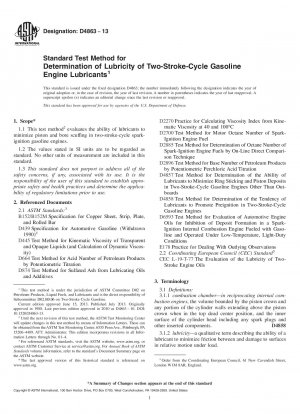ASTM D4863-13
Standard Test Method for Determination of Lubricity of Two-Stroke-Cycle Gasoline Engine Lubricants
- Standard No.
- ASTM D4863-13
- Release Date
- 2013
- Published By
- American Society for Testing and Materials (ASTM)
- Latest
- ASTM D4863-13
- Scope
5.1 The oil in a two-stroke-cycle gasoline engine is either mixed with the fuel prior to use or is metered into the fuel supply at, or at some point prior to, its passage into the engine crankcase. The possibility of the amount of oil actually present in the engine being less than optimum always exists. Also, with some oil metering systems short periods of operation with less oil than desirable can occur when the power is increased suddenly. It has also been found that the incidence of piston scuff early in the life of the engine might be related to the lubricity of the oil used as defined by test procedures of this type.
1.1 This test method2 evaluates the ability of lubricants to minimize piston and bore scuffing in two-stroke-cycle spark-ignition gasoline engines.
ASTM D4863-13 Referenced Document
- ASTM B152/B152M Standard Specification for Copper Sheet, Strip, Plate, and Rolled Bar
- ASTM D2270 Standard Practice for Calculating Viscosity Index From Kinematic Viscosity at 40 and 100176C
- ASTM D2700 Standard Test Method for Motor Octane Number of Spark-Ignition Engine Fuel
- ASTM D2885 Standard Test Method for Research and Motor Method Octane Ratings Using On-Line Analyzers
- ASTM D2896 Standard Test Method for Base Number of Petroleum Products by Potentiometric Perchloric Acid Titration
- ASTM D439 Standard Specification for Automotive Gasoline
- ASTM D445 Standard Test Method for Kinematic Viscosity of Transparent and Opaque Liquids (the Calculation of Dynamic Viscosity)
- ASTM D4857 Standard Test Method for Determination of the Ability of Lubricants to Minimize Ring Sticking and Piston Deposits in Two-Stroke-Cycle Gasoline Engines Other Than Outboards
- ASTM D4858 Standard Test Method for Determination of the Tendency of Lubricants to Promote Preignition in Two-Stroke-Cycle Gasoline Engines
- ASTM D6593 Standard Test Method for Evaluation of Automotive Engine Oils for Inhibition of Deposit Formation in a Spark-Ignition Internal Combustion Engine Fueled with Gasoline and Operated Under Low-Temperature
- ASTM D664 Standard Test Method for Acid Number of Petroleum Products by Potentiometric Titration
- ASTM D874 Standard Test Method for Sulfated Ash from Lubricating Oils and Additives
- ASTM E178 Standard Practice for Dealing With Outlying Observations
ASTM D4863-13 history
- 2013 ASTM D4863-13 Standard Test Method for Determination of Lubricity of Two-Stroke-Cycle Gasoline Engine Lubricants
- 2010 ASTM D4863-10 Standard Test Method for Determination of Lubricity of Two-Stroke-Cycle Gasoline Engine Lubricants
- 2008 ASTM D4863-08 Standard Test Method for Determination of Lubricity of Two-Stroke-Cycle Gasoline Engine Lubricants
- 2002 ASTM D4863-02 Standard Test Method for Determination of Lubricity of Two-Stroke-Cycle Gasoline Engine Lubricants
- 2000 ASTM D4863-00 Standard Test Method for Determination of Lubricity of Two-Stroke-Cycle Gasoline Engine Lubricants
